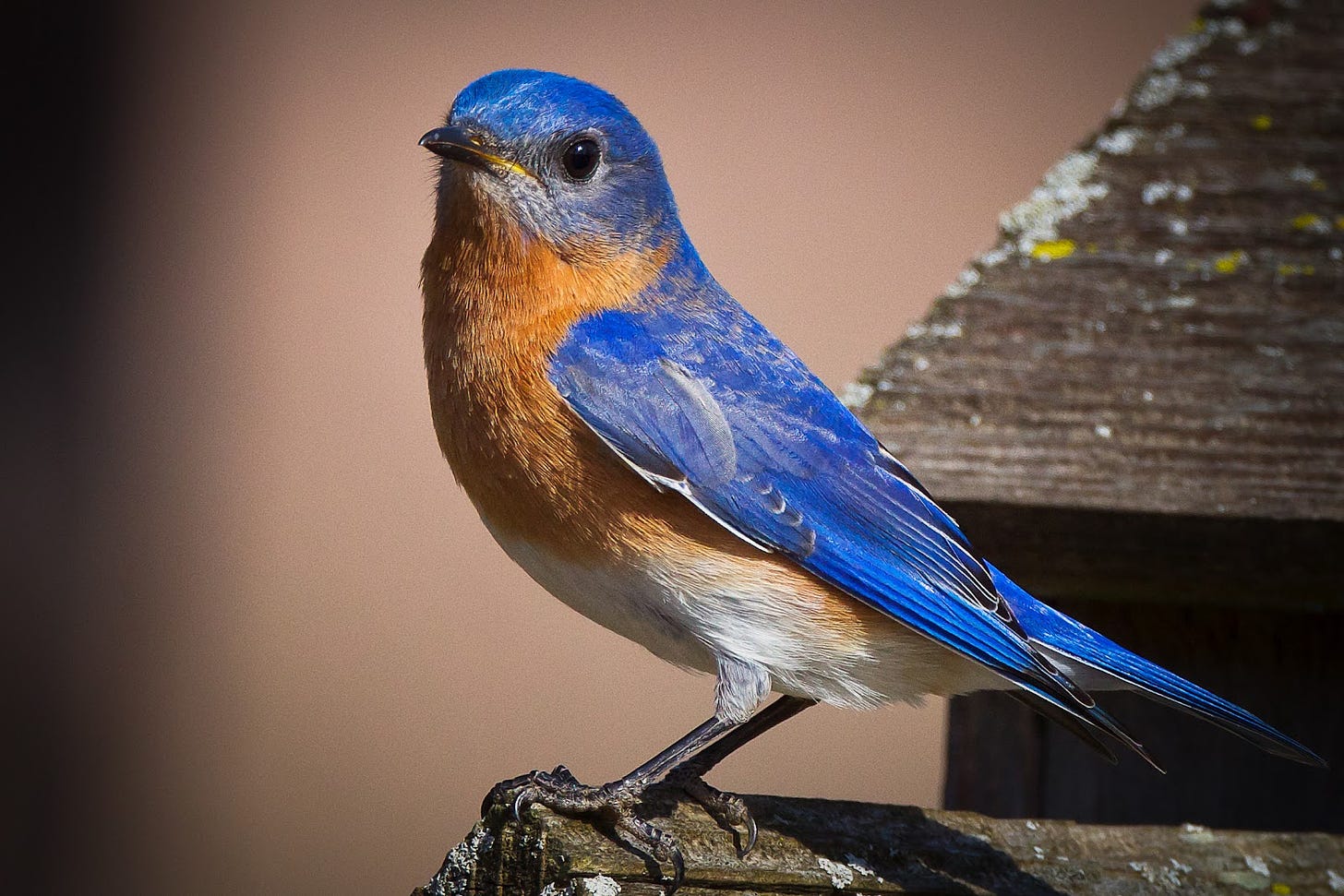News of the week
New birdhouses for eastern bluebirds. Volunteers needed for California Bumblebee Atlas. Glow-in-the-dark fish in Brazil.
New birdhouses for bluebirds
Folks with the Anacostia Watershed Society are building birdhouses for bluebirds. Eastern bluebirds have suffered a serious decline in recent decades, owing to competition for nesting sites from the introduced European starling and house sparrow.1 The decline was so great that some ornithologists and bird enthusiasts thought that the beautiful and much loved bird would go extinct. Although urban adapted, increased sprawl has probably also been a factor in the bluebird’s decline. Individuals
and organizations—like the folks from Anacostia—building birdhouses specifically designed for the eastern bluebird are credited with this bird making an incredible comeback.2
Eastern bluebirds, distinguished by their chestnut throats and breasts and blue wings and backs, live throughout the eastern United States, from the Atlantic states, south into Florida, and west, just past the Mississippi River. Typically building nests in April and laying their pale blue eggs in May, they can be found during the spring and summer nesting as far north as the southern portions of eastern Canada.3
The Maryland based organization installed eight birdhouses in a meadow that they had restored in recent years. The birdhouses have a corrugated metal baffle to keep out predators, such as raccoons and snakes, and an entryway that is too small for house sparrows to enter. (Anacostia Watershed Society)
Volunteers sought to complete Bee Atlas
In the last ten years or so, a number of institutions have published atlases of birds, plants, and other living things. They are wonderful resources and serve as tools for researchers and conservationists. They also take A LOT of work to put together. It takes dozens or hundreds of individuals willing to put in a great deal of time surveying or searching for butterflies, birds, or plants to make an atlas complete.
Starting this month, a coalition of the Bureau of Land Management, California Department of Fish and Wildlife, and the Xerces Society for Invertebrate Conservation, has commenced the creation of a bumblebee atlas for the entire state of California. They are seeking volunteers for field work to survey the bees.
An atlas of this type is much needed now. California is home to 25 species of bumblebees, and much of their current distribution remains unknown. A quarter of California’s bumblebee species face extinction.
After training on how to collect information on the bees, volunteers will adopt survey areas and sample for the insects several times in a season. The effort will concentrate on California’s six bumblebee species of greatest concern: the western bumble bee, Morrison bumblebee, Crotch’s bumblebee, obscure bumblebee, Suckley cuckoo bumblebee, and Franklin bumblebee. The Franklin bumblebee, which has not bee seen since 2006, was listed as Endangered by the U.S. Fish and Wildlife Service in August of 2021. Other bumblebee species are currently under consideration for similar protections.
Bee species, as well as other native pollinators, have suffered declines because of habitat loss, pathogens, pesticides, and climate change. By identifying where the species of bumblebees live, the coalition hopes to better identify the resources upon which they rely and improve efforts to conserve the bees.
“Bumble bees are critically important pollinators in both agricultural and natural ecosystems,” says Scott Gardner, Wildlife Branch Chief with the California Department of Fish and Wildlife. “While we know there have been recent declines, the extent in California remains largely unknown. This project offers volunteer community scientists the opportunity to fill this gap and help us develop a strategy to better conserve pollinators.”
If you’re interested in putting in a great deal of very rewarding time for this project, you can register to be a volunteer here. (Xerxes Society)
Glowing fish released to the wild
Fish that have been genetically modified to glow in the dark have been released into the rivers in Brazil. The fish, which are called by the marketing researched name GloFish, have been found in all five headwaters of the Paraíba do Sul River Basin, a watershed of 21,400 square miles that lies just north of Rio De Jainero and flows north northeast to the Atlantic. It is the watershed that has been the most heavily influenced and degraded by human activity.
Some biologists have voiced the fear that these introduced fish—which are advertised for sale online in Brazil, despite being banned in the country—could drive native species to extinction. They feed on the same insects and zooplankton that native fish eat and could potentially out-compete the native populations.
The GloFish are supposed to be infertile, but some biologists claim that they are reproducing in some of the headwaters of the Paraíba do Sul. These glow-in-the-dark fish were created in the late 1990s at the University of Singapore and are marketed by a U.S. company, Yorktown Technologies, under the name GloFish.
Since their creation, little concern has been expressed over the GloFish being released into the wild, including from the U.S. Food and Drug Administration. The thinking has been that an inferior genetically modified organism would not fair in the wild as well as normal organisms, and the GloFish would die out. Some studies seem to confirm this thinking, but the GloFish continue to swim in Brazil. (Monga Bay)
For more environmental science and news follow me on Twitter @EcoScripsit.
National Geographic Field Guide to the Birds of North America Fifth Edition. National Geographic Society, Washington, DC 2006 pp 354
Ibid
ibid





